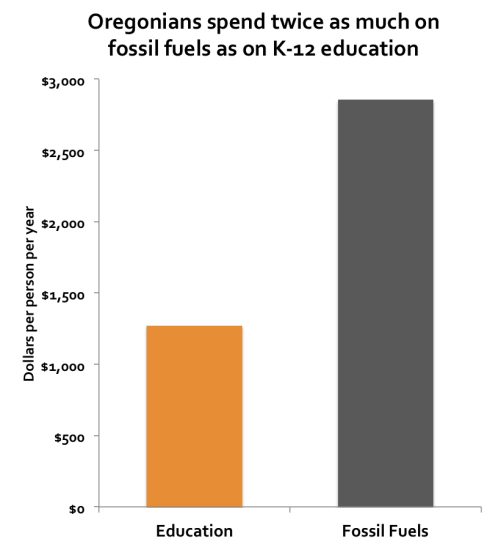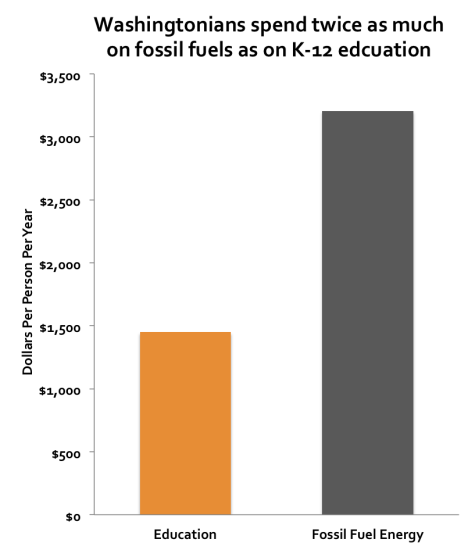If you could choose how much of your money to spend on fossil fuels compared to K-12 public schools, how would you divvy up your dollars?
Here’s where your money actually goes:
- If you live in Oregon, you spend around $1,300 per year on K-12 education and around $2,800 per year on fossil fuels.
- If you live in Washington, you spend around $1,500 per year on K-12 education and around $3,200 per year on fossil fuels.

Original Sightline Institute graphic, available under our free use policy.

Original Sightline Institute graphic, available under our free use policy.
How much of your money stays in the state?
Most of the money you spend on education creates jobs in your state—it pays teachers, maintenance workers, administrators, and food service workers. Very little of your education money leaks out of the state; some supplies and food are purchased from out of state and some money pays for, well, fossil fuels to run the school buildings and power the school buses. In addition to being a local job creator, public education also creates an educated workforce that creates prosperity for the state. Despite these benefits, both Oregon and Washington spend less than the national average per K-12 student.
In contrast, most of the money you spend on fossil fuels flies straight across the border. Two-thirds to three-quarters of the price of fossil fuels pays for the raw resources—crude oil, coal, and natural gas—but neither Oregon nor Washington produce any fossil fuels, so all that money goes elsewhere. One-quarter to one-third of fossil fuel money stays in state: Washingtonians pay about 15 percent of the total cost of oil to in-state refineries, both Oregon and Washington pay for in-state coal power plants (although Boardman and Centralia are both scheduled to close down within a decade), and distributing the oil or power within the state accounts for less than 10 percent of the price. But even in-state fossil fuel expenditures don’t create many jobs. A million dollars invested in oil or natural gas only creates one direct job compared to investing in building retrofits, which creates seven times as many.
Making polluters pay for education
I’m going to guess that, given your druthers, you wouldn’t choose to spend twice as much money on out-of-state, planet-polluting fossil fuels as on job-creating, next-generation-empowering public schools. But perhaps you feel stuck—you have to get to work somehow, your groceries have to get to the store somehow, you have to turn the lights on, and even the Pacific Northwest’s abundant hydropower can’t light the whole region by itself. To get unstuck, we need to transition to a clean energy economy where you don’t feel trapped by fossil fuels and where the legislatures see a path to properly fund K-12 education. The first step is to hold polluters responsible for their pollution. In Washington, Governor Inslee’s proposal to make polluters pay for their pollution and to invest the money in schools and transportation projects would do just that. In Oregon, watch for similar proposals in the year ahead.
Technical Notes:
Oregon
- Oregon now spends around $5 billion per year on K-12 public schools. In 2013, Oregon increased its state K-12 budget by about $1 billion, allocating $6.55 billion to K-12 education for the 2013-2015 biennium, or $3.275 billion per year. Schools also get about $1.55 billion per year from local taxes and a smaller amount from federal funds.
- I divided $5 billion by Oregon’s population of 3.93 million to get per capita spending of around $1,300 per year.
- According to Energy Information Administration (EIA) data, Oregon spends $11.2 billion each year on fossil fuels—petroleum, natural gas, and coal.
- I divided $11.2 billion by Oregon’s population of 3.93 million to get per capita spending of around $2,800 per year.
Washington
- For the 2012-2013 school year, Washington spent $10.1 billion on K-12 education. The money came mostly from state taxes, with about 20 percent from local taxes, 9 percent from federal taxes, and a small amount from other revenue.
- I divided $10.1 billion by Washington’s population of 6.971 million to get per capita spending of around $1,500 per year.
- According to EIA data, Washington spends $21.2 billion each year on fossil fuels—petroleum, natural gas, and coal.
- I divided $21.2 billion by Washington’s population of 6.971 million to get per capita spending of around $3,200 per year.









jerome parker
Great (and persuasive) article.
A key to reversing these costs is land use: more compact cities make walking, biking, and transit feasible.
Dick Burkhart
You need to be careful about your jobs argument. While the delivery and distribution of fossil fuels does not involve many jobs, the “use value” of those fossil fuels is enormous – producing most of our wealth. Without them our economy would quickly grind to a halt, leaving almost no jobs. That is, our economy is still far too dependent on fossil fuels.
Sameer
Dick – The key point is to replace those fossil fuels with cleaner and cheaper alternative fuels – which exist. That way you don’t lose the ‘use value’ of the fossil fuels.
Levin Nock
Great article, thanks for putting this in perspective. To invest the regional fossil fuel budget in something that serves the regional economy better, electric vehicles (EV’s) seem like a step in a good direction, because we can make clean electricity locally. Still, most EV’s are manufactured elsewhere.
BTW, it’s not exactly true that “even the Pacific Northwest’s abundant hydropower can’t light the whole region by itself.” Hydropower delivers over 60% of regional electricity. Lighting uses roughly 13% of electricity today, and LED lights are expected to cut lighting’s share down to 8% by 2030. So, if all we want is lighting, there’s plenty of hydro. If we want lighting plus comfortable buildings plus plug loads plus industry plus access to goods and services, then hydro offers a valuable cornerstone on which to build a regional clean energy economy.
Kristin Eberhard
Thanks Levin. Yes, I should have said hydro can’t power the whole region by itself.
Ross Hunter (@rosshunter)
Your lovely chart has a typo – “Edcuation” in the Washington version.